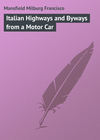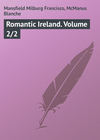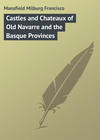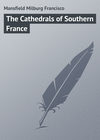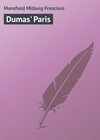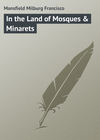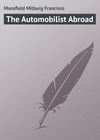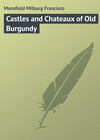Czytaj książkę: «Italian Highways and Byways from a Motor Car», strona 11
The ducal family of Este lived the life of the times to the limit of their powers. They, one and all, inherited a taste for crimes of various shades, just as they inherited the love of art. Alfonso, Duke of Ferrara, had no profound moral sense in spite of his finer instincts, and was so “liberal minded” that he shocked Bayard, the “chevalier sans peur et sans reproche,” into crossing himself “more than ten times” as an antidote, when he first came into the ducal presence.
Ferrara’s castello or castel vecchio, which is better known as its ducal château, is a remarkable specimen of military architecture. On Saint Michael’s Day, 1385, its first stones were put in place by Bartolina di Novara, and the ardour of the workmen was so great that at the end of sixteen months the work was completed as it is to-day, with its towers, its doubly thick walls, and all its brutal force.
A fosse surrounds the edifice, and two gateways only give access to the interior. Under Alphonso I certain embellishments were added to the old castle, bringing it up to the times in luxurious decorative details and the like. The rude feudal castle now became virtually a residential château. The crenelated battlements were transformed into mere parapets, the chemins de ronde into terraces and hanging gardens.
Pictures and frescoes were at this time added liberally, and, though to-day many of these have been dispersed to the four corners of Europe, enough remain to indicate the importance of these new embellishments.
The cachots or dungeon cells still exist, and are regarded – by the guardian – as one of the chief “sights.” Some others may think differently.
The house of Ariosto is one of Ferrara’s most popular attractions, though indeed it is not remarkable architecturally. Ariosto was one of the brilliant figures of the Ferrara court, but his house was modest and bare, as is remarked by a tablet which it bore in the poet’s time, and on which was carved in Latin: “My house is small but was built for my own convenience and entirely with my own money.” How many householders of to-day can say the same?
In the hospital in the southern quarter of the town is still to be seen the prison cell commonly assigned to Tasso. On the walls are scribbled the names of Lord Byron and Casimir Delavigne and Lamartine’s verses on Tasso, and over the door runs the inscription —

For seven years and more Tasso lived within these four narrow walls.
“Ferrara! in thy wide and grass-grown streets
Whose symmetry was not for solitude,
There seems as ’twere a curse upon the seats
Of former sovereigns, and the antique brood
Of Este...... .
And Tasso is their glory and their shame.”
“Childe Harold.”
Closely bound with Ferrara and the fortunes of the family of Este is the town of that name midway between Ferrara and Padua at the foot of the Euganean Hills. The ancestral residence of the family of Este is here, but in a more or less ruinous state to-day.
The “Rocca” or Castle of Este was erected in 1343 by Ulbertino Carrara, and repaired by the Scaligers during their temporary possession of it. It is a noble dungeon tower, with frowning embrasures and battlements, and stands at least upon the site of the original fortress. Alberto Azzo (born 996) was the more immediate founder of the house here on the death of the Emperor Henry III. The ancestry of Alberto may be traced in history to Bonifazio, Duke or Marquis of Tuscany, in 811. Poetry carries it much higher. The magician, in the vision of the enchanted shield, enables Rinaldo to behold Caius Attius as his remote ancestor: —
“Mostragli Caio allor, ch’a strane genti
Va prima in preda il gia inclinato Impero,
Prendere il fren de’ popoli volenti,
E farsi d’Este il Principe primiero;
E a lui ricoverarsi i men potenti
Vicini, a cui Rettor facea mestiero,
Poscia, quando ripassi il varco noto,
A gli inviti d’Honorio il fero Goto.”
– Orlando Furioso.
Guelph, Duke of Bavaria (succeeded 1071), from whom all the branches of the House of Brunswick are descended, was the son of Alberto Azzo, Marquis of Este, by his first wife, Cunegunda, a princess of the Suabian line.
Fulco I, Marquis of Italy and Lord of Este, the son of Alberto Azzo by his second wife, Garisenda, daughter of Herbert, Count of Maine, was the founder of the Italian branch from which the Dukes of Ferrara and Modena descended, the male line of which became extinct at the end of the last century. The Duke of Modena, who was deposed in the mid-nineteenth century, represented the house of Este in the female line, – his grandmother, Maria Beatrix, having been the last descendant of the Italian branch. Este continued in the possession of the descendants of Alberto until 1294, when it fell an easy conquest to the Carraras. Successively a dependency of Padua and of the Verona Scaligers, it passed to Venice in 1405, retaining its local government and municipal institutions.
Near Este is Arqua, where Petrarch died in 1374. It has been a literary shrine since 1650, for a chronicler of that time remarks it as one of the things to come to Italy to see. The house is still to be seen, and the sarcophagus containing his remains and an inscription beginning —
“Frigida Francisci lopis hic tegit ossa Petrarce”
is before the tiny church of this little frequented and little exploited village.
CHAPTER XV
ON THE VIA ÆMILIA
THE Via Æmilia of antiquity is a wonder to-day, or would be if it were kept in a little better repair. As it is, it is as good a road as any “good road” in Italy, and straight as an arrow, as it runs boldly from the Adriatic at Rimini to Piacenza, through the ancient States of Bologna, Modena and Parma.
No automobilist who ever rolls off its length of 262 kilometres will class it as inferior to any other Italian road of its class.
The following categorical mention of the cities and towns on this great Roman way presents their varied charms in a sufficient number, surely, to make the hurried north or southbound traveller think it worth while to zigzag about a bit, in going from Florence to Venice, in order to visit them all.
The first place of note after leaving Rimini is Cesana – “She whose flank is washed by Savio’s wave,” Dante wrote.
Cesana is full of reminders of the profligate Cæsar Borgia. The library of Cesana was famous in mediæval times and held its head high among the city’s other glories. Above all was the famous Rocca of Cesana, a fortress château of great strength in days when feudal lords needed a warren into which they might run and hide at every league.
The Palazzo Publico is a square, sturdy, none too lovely building with some notable pictures within, and a statue of Pius VII, who was a native of the place.
In the stirring times of the pontificate of Gregorius XI, the Avignon Pope sent a cut-throat Cardinal into Italy at the head of a band of soldiery who entered and pillaged Cesana in 1377. His cry at the head of his troops was ever: “Blood! more blood! Kill! Kill! Kill!” A nice sort of a man for a Cardinal Prince of the Church!
The highroad between Cesana and Rimini passes through the valley of the Rubicon. Mule tracks, sloping hills and olive groves are the chief characteristics of this vale, the spot where Cæsar apocryphally crossed the Rubicon. Historians up to Montesquieu’s time seemed to take it for granted, but latterly it has been denied.
Forli and Imola were the principal towns of Romagna, the patrimony of Catherine Sforza and Girolamo Riario, nephew of Pope Sixtus IV. When the new married pair first came to their little State from Rome the Renaissance was at its height, and the ambitious bride sought, so far as possible, to surround herself with its splendours. Their reign in the east was not happy; Girolamo proved a tyrant, and was promptly assassinated by his followers, leaving Catherine and her five children completely in the power of his murderers, who made her give up her claims to her little kingdom. She consented, or pretended to consent. She conspired with the Governor of the fortress, Tommaso Feo, and appeared on its ramparts dressed as a warrior. She refused to surrender, and when it was recalled that she had left her children behind as hostages she cruelly replied: “In time I shall have others.” Catherine Sforza was a bloodthirsty vixen, surely.
Forli was Catherine Sforza’s own city, and her defence of it against the Borgias was one of the celebrated sieges of history. She held out two years, and then only gave in because she was betrayed. Her very reason of warring with the Borgias reflects greatly on her credit. She refused simply to allow her son to marry the aging Lucrezia; “not so much on account of her age,” said Catherine, “as her morals.” Princely marriages are often carried out on different lines to-day.
Almost within sight of Forli is Faënza, a city which was under the domination of the Manfredi when Cæsar Borgia took it into his head to move against it. A young prince by the name of Astor III, but eighteen years of age, beloved by all for his amiability, grace and youth, held its future in his hands. When the key of Faënza, Brisighella, fell to the Borgia’s captain of artillery in the early days of November in 1500, the emperor-like Cæsar himself came forward and took command. He offered life to the dwellers within the walls if they would surrender, but they would have none of it, for, as the Borgia wrote in a letter to the Duc d’Urbino, dated from “the pontifical camp before Faënza,” a “dramatic defence was made by the citizens of the town.” This “dramatic defence” was such that it compelled Borgia and his papal soldiers to go into winter quarters. The struggle was the longest that Borgia had yet undertaken in his campaigns, and the women of Faënza, as did Catherine Sforza at Forli, covered themselves with glory.
A daughter of a soldier of the garrison, Diamante Jovelli, put herself at the head of a band of Amazons who took entire charge of the commissariat, the handling of the munitions of war, and served as sentinels, repairing the walls even when breached – rough work for women. “The women of Faënza have saved the honour of Italy,” wrote Isabella d’Este in 1501 to her husband, the Duke of Mantua, and Cæsar Borgia himself committed himself to paper with the following words: “Would that I had an entire army of the women of Faënza.” The city fell in due time, and the crafty Cæsar honoured the gallant Manfredi, “crowned with the laurels of valour and misfortune,” by allowing him “a guard of honour and all his proper dignities.” Later the Borgia repented of his generosity, and sent the young and gallant prince to Rome, and imprisoned him in the Castle of Sant’Angelo for a year.
Faënza is a very ancient town, and less populous to-day than it was fifty years ago, when also it was less populous than it was five hundred years ago.
Imola, the seventh place of importance on the Æmilian itinerary counting from Rimini, was the ancient Forum Cornelii, but by Charlemagne’s time it had already become known by its present name. In the middle ages Imola’s geographical position, midway between Bologna and Romagna, made it an important acquisition in the contests for power. It was successfully held by many different chiefs, and was united to the States of the Church under Julius II. As one of the stations on the Æmilian Way, it was a place of some importance; it is mentioned by Cicero, and by Martial: —
“Si veneris unde requiret,
Æmiliæ dices de regione viæ.
Si quibus in terris, qua simus in urbe rogabit,
Corneli referas me, licet, esse Foro.”
The fortress château of Imola was almost identical in form with that of Forli, quadrilateral with four great towers at the angles, and a crenelated battlement at the skyline.
Cæsar Borgia brought this fortress to ignoble surrender in 1499, but since the fortress was then quite independent of the city he had still another task before him before the inhabitants actually came within his powers. A fortnight after the capture of the fortress the city itself fell. Imola was a part of the marriage dot of Catherine Sforza, who confided its defence to Dionigi di Naldo while she busied herself at Forli, where she reigned as widow and inheritor of Riario Sforza.
On towards Bologna one passes Castel San Pietro, a thirteenth century fortified town still sleeping its dull time away since no war or rumours of war give it concern. Quaderna, even less progressive and important to-day than its neighbour, was the important station of Claternum in the days when traffic on the great Æmilian way was greater than now.
Bologna’s towers and domes loom large on the horizon as one draws up on this great capital from any direction. Bologna, because of its easy access, is one of the popular tourist points of Italy, and for that reason it is omitted from nobody’s itinerary, though most hurried travellers remember the mortadella better than they do the cathedral, which in truth is nothing very fine so far as architectural masterpieces go.
The roads in and out of Bologna are quite the best to be found neighbouring upon a large city in Italy. They shall not be described further, the mere statement that this is so should be taken as sufficient praise.
The streets within the gates too, though paved, are splendidly straight and smooth, though encumbered at one or two awkward corners with tram tracks.
The visitor to Bologna may take his ease at the Hotel Brun, quite the most distinguished hotel in all Italy, not even excepting Daniellis or the Grand at Venice, each of them a palazzo of long ago.
The Hotel Brun is a red brick palace of imposing presence, with a delightful courtyard where you may stable your automobile along side of those of most of the touring nobility of Europe at a cost of two and a half francs a night. The hotel in spite of this is excellent in every way.
Bologna is surrounded by a city wall pierced by twelve gateways and thus well preserves its mediæval effect in spite of its theatres, cafés and restaurants, which are decidedly modern and unlovely.
Bologna when it was conquered by the Gauls took the name of Bononia. Under Charlemagne it became a free city and had for its device the equivalent of the word Liberty.
Bologna, the ancient city, proud in the middle ages and independent always, has ever been the cradle of disturbing factions, a revolutionary precursor of new ideas, and has been sold and sold again by first one Judas and then another.
Bologna is, taking its history, its present day prosperity and its still existing mediæval monuments into consideration, the most impressive and imposing of all the secondary cities of Italy, indeed in many of the things that impress the traveller it is ahead, far ahead, of Florence.
Paul Van Herle, a fifteenth century Dutchman, first called the city Bologna la Grassa because of the opulency of the good things of the table which might be had here. Its wines and its grapes are superlative, and its mortadella, or Bologna sausage, is, to many, a delicacy without an equal.
Bologna seems to have a specialty of leaning towers, though the school histories and geographies always use that of Pisa to illustrate those architectural curiosities. Their histories are very romantic, and the mere fact that they are out of perpendicular takes nothing away from their charm. The two leaning brick towers of Bologna’s Piazza di Porta Ravegnana, the Torri Asinelli and the Torri Gorisenda, the first nearly a hundred metres in height and the latter about half that height, are two of the most remarkable structures ever erected by the hand of man.
The Asinelli tower was built in 1109, and its neighbour, which never achieved its completion, in the following year.
From Bologna to Modena is thirty-two kilometres and midway is Castel Franco or Forte Urbano, as it is variously known. It was formerly the Forum Gallorum of the Romans and still has its castel little changed from what it was in the days when Urban VIII built it.
Modena is mostly confounded by hurried travellers with Modane, though the latter is merely a railway junction where one is tumbled out in the middle of the night to make his peace with railway and customs officials.
Modena’s Palazzo Ducale, now the Palazzo Reale, was and is a vast, gaudy construction, not lovely but overpowering with a certain crude grandeur. A military school has now turned it to practical use. It never could have been good for much else. A picture gallery and Cæsar d’Este’s famous library are quartered in the Albergo Arti, built by the Duke Francesco III in the seventeenth century.
The library Biblioteca Estense was brought from Ferrara in 1598 by Cæsar d’Este on his expulsion by Clement VIII. It contained 100,000 volumes and 3,000 MSS. Three of the most learned men in Italy during the last century – Zaccaria, Tiraboschi and Muratori – were its librarians. Amongst the treasures were a gospel of the third century, a Dante with miniature of the fourteenth century, a collection of several hundred Provençal poems, etc.
Modena was the birthplace of Mary of Modena, the fascinating princess who became the Italian Queen of the English people, the consort of James II. She was an Italian Princess of the house of Este. Her mother was the Duchess Laura of Modena, daughter of Count Martinozzi and Margaret Mazarini, cousin of the great Cardinal Mazarin, and she was married, under his auspices, at the Chapel Royal of Compiègne, in 1655, by proxy, to Alfonso d’Este, hereditary Prince, and afterwards Duke Alfonso IV of Modena.
When Lord Peterborough, the envoy of the Duke of York, was shown the portrait of the Princess Mary he saw “a young Creature about Fourteen years of Age; but such a light of Beauty, such Characters of Ingenuity and Goodness as it surprised him, and fixt upon his Phancy that he had found his Mistress, and the Fortune of England.” He made every effort to meet her personally, but in vain; so he was introduced, “by means such as might seem accidental,” to the Abbé Rizzini, who was employed at Paris to negotiate the interests of the House of Este. This man attributed “many excellencies to Mary of Modena, yet he endeavoured to make them useless” to them by saying that she and her mother wished that she might take the veil. It was later learned that obstacles were put in the Duke of York’s way until he announced his willingness to become a Roman Catholic.
Reggio in Æmilia, passed on the road to Parma, is a snug little town, supposedly the birthplace of Ariosto. A house so marked compels popular admiration, but again it is possible that he was born within the citadel, since razed.
The Duchies of Parma and Modena counted little in the political balance in their day, but the fêtes and spectacles of their courts were frequently brilliant.
The Duchy of Parma and of Piacenza was created in 1545 by the Pope Paul III for his son Pietro Farnese. Little of Parma’s mediæval character remains to-day. The town is said to have been called Parma from its similarity to the form of a shield. But the torrent Parma, which runs through the city, crossed by three bridges, besides the railway bridge, most probably gave its name to the city which arose upon the banks. When the city was under the authority of the Popes it was represented by a female figure sitting on a pile of shields, and holding a figure of Victory, with the inscription of Parma aurea. Let the heraldic students figure out any solution of the incident that they please, or are able.
The Via Æmilia divides the city, by means of the Strada Mæstra, into two very nearly equal parts. Parma, like Modena and Lucca, has changed its fortification walls into boulevards, called “Stradone,” which are the favourite rendezvous for Parmesan high society when it goes out for a stroll.
Near Parma is Canossa, the site of an old fortified town, one day of considerable importance, but now decayed beyond hope. Here the Emperor Henry IV, bareheaded and barefooted, supplicated Pope Gregory V in 1077, an incident of history not yet forgotten by the annalists of church and state.
Soon after leaving Parma the Roman road crosses the river Taro, the boundary frontier which shut off the Gaulish from the Ligurian tribes. The Brothers of the Bridge here built a great work of masonry in 1170, obtaining money for the expense of the work by begging from the travellers passing to and fro on the Æmilian Way. In time this old bridge was carried away, and for centuries a ferry boat served the purpose, until, in fact, the present structure came into being.
Borgo San Donino, some twenty kilometres beyond the Taro, marks the shrine of San Donino, a soldier in the army of Maximilian who became a Christian and refused to worship as commanded by his Emperor. For this he was put to death on this spot, and for ever after Borgo San Donino has been one of the most frequented places of pilgrimage in Italy.
Fiorenzuola, still on the Via Æmilia, a dozen kilometres farther on, has still an old tower to which hang fragments of an enormous chain by which criminals once were bound and swung aloft.
All through this fertile, abundant region through which runs the famous Roman Road are numerous little borgos, or villages, bearing names famous in the history of Italy and its contemporary minor states.
Piacenza was founded by the Gauls and was afterwards by the Romans named Placentia. It has ever prospered, though its career has been fraught more than once with danger of extinction. By the tenth century its great trading fair was famous throughout Europe.
Piacenza is full of palaces, statues and monuments which merit the consideration of all serious minded persons, but the automobilist who has made the last fifty kilometres of the Via Æmilia in the rain – and how much it does rain in Italy only one who has travelled there by road for weeks really appreciates – is first concerned as to where he may lay his head and house his car free from harm.
The Grand Hotel San Marco answers his needs well enough and has the endorsement of the Touring Club de France as well as that of the Italian Touring Club, but it is ridiculous that one is obliged to pay in a smug little Italian town of thirty-five thousand inhabitants five francs a night for housing his automobile.
Piacenza is on the direct road to the Italian Lakes via Milan, from which it is distant seventy kilometres.
